Bordered by Lake Michigan to the east, and Lake Superior to the north, Wisconsin is also home to more than 15,000 inland lakes. Add that to a host of large rivers and wetland habitats, et voila! you’ve got a duck’s paradise.
Wisconsin lies at an interesting point on the map for ducks – south of the breeding grounds for most species, but north of the main wintering grounds. This means that the time you’ll see most ducks in Wisconsin is in the spring and fall when huge flocks of them pass through the state.
Some ducks, however, like to settle in Wisconsin for breeding, overwintering, or both, and these are the species we’ll be taking a closer look at here.
Mallard
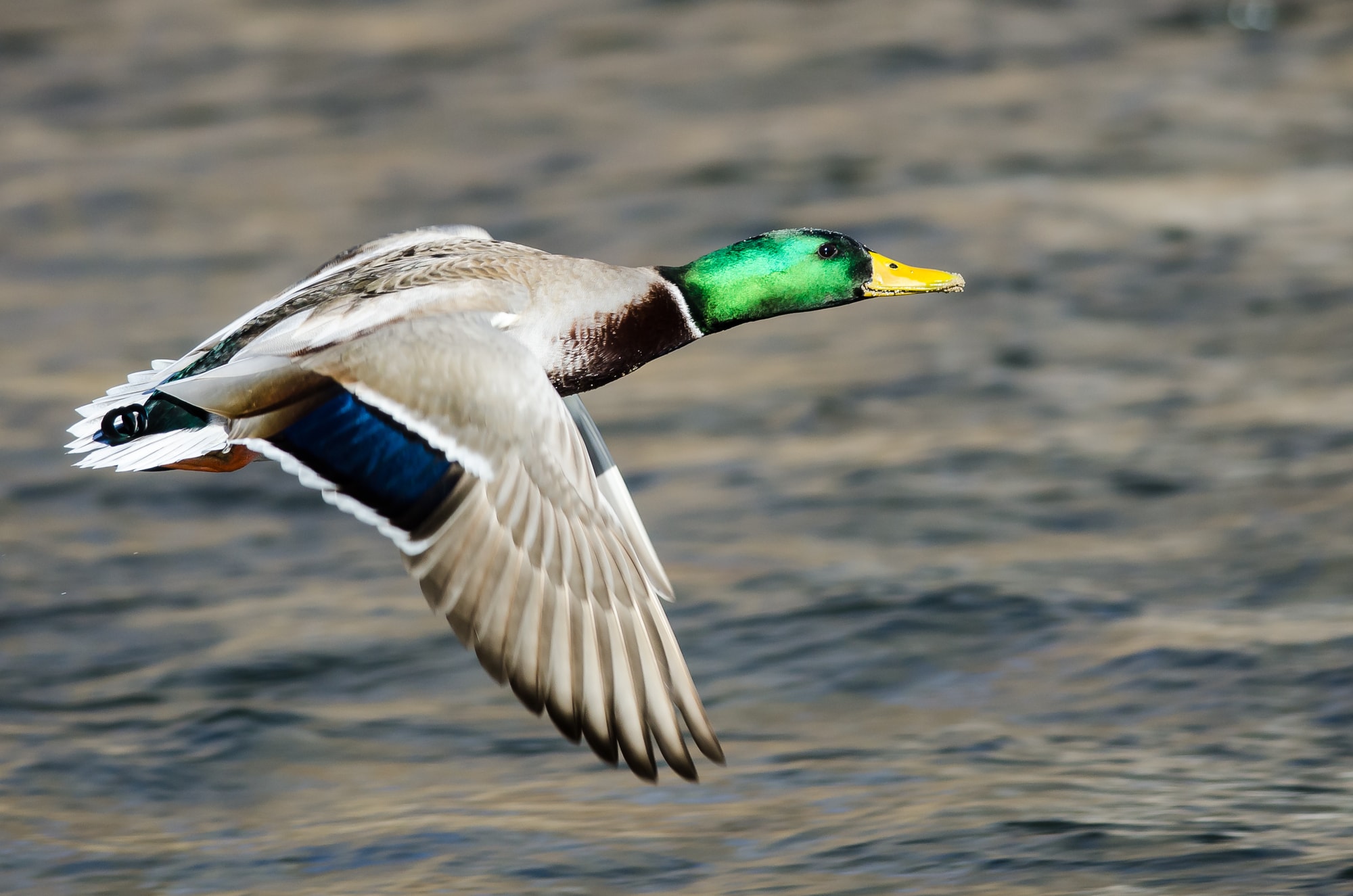
- Scientific Name: Anas fulvigula
- Length: 18.5-21 inches
- Weight: 24.7-40.6 ounces
- Wingspan: 31.5-34.3 inches
The most common duck in Wisconsin? You’ve guessed it! It’s the ubiquitous Mallard. With their gorgeous glossy green heads, Mallards are an icon of waterfowl and the forefather of many domestic duck varieties.
Mallards have been making friends with humans for centuries and they’re often one of the first to come over if they see a feeding opportunity!
Just be discerning if you’d like to partake in feeding ducks because large quantities of bread can be harmful to their health. Small quantities of grains, peas, or even split grapes are a better choice.
Mallards can be seen all year round in Wisconsin, but more often in summer when more than 1 in 4 people report them on their bird-watching checklists.
Wood Duck
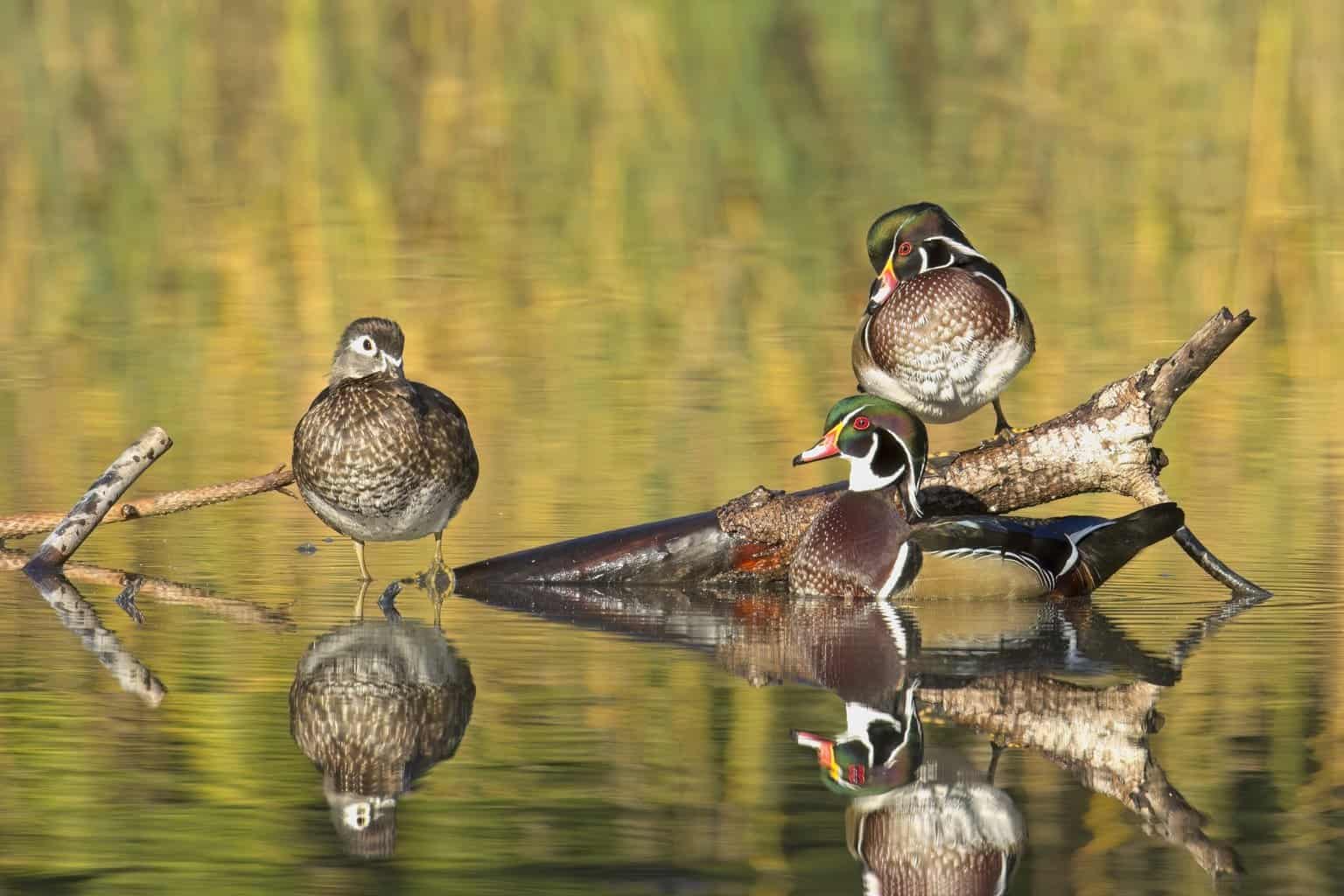
- Scientific Name: Aix sponsa
- Length: 18.5 – 21.3 in
- Weight: 16.0 – 30.4 oz
- Wingspan: 26.0 – 28.7 in
The second most common duck during the summer in Wisconsin is the one and only, spectacular Wood Duck!
Sure to charm any bird lover, the epic, cartoon-like green crested-head of the male in the breeding season is both beautiful and comical.
Wood Ducks also have some very funny breeding habits. The female lays up to 16 eggs in a tree cavity up to 60 feet off the ground, which the poor little hatchlings have to jump down from within hours of hatching out!
The mother duck stands at the bottom of the tree, calling to her young to jump, before hurrying across the forest floor with them to the nearest lake or pond.
Sometimes Wood Ducks will even lay their eggs in another female’s nest for her to raise instead. Now there’s a duck that can make you laugh!
Blue-winged Teal
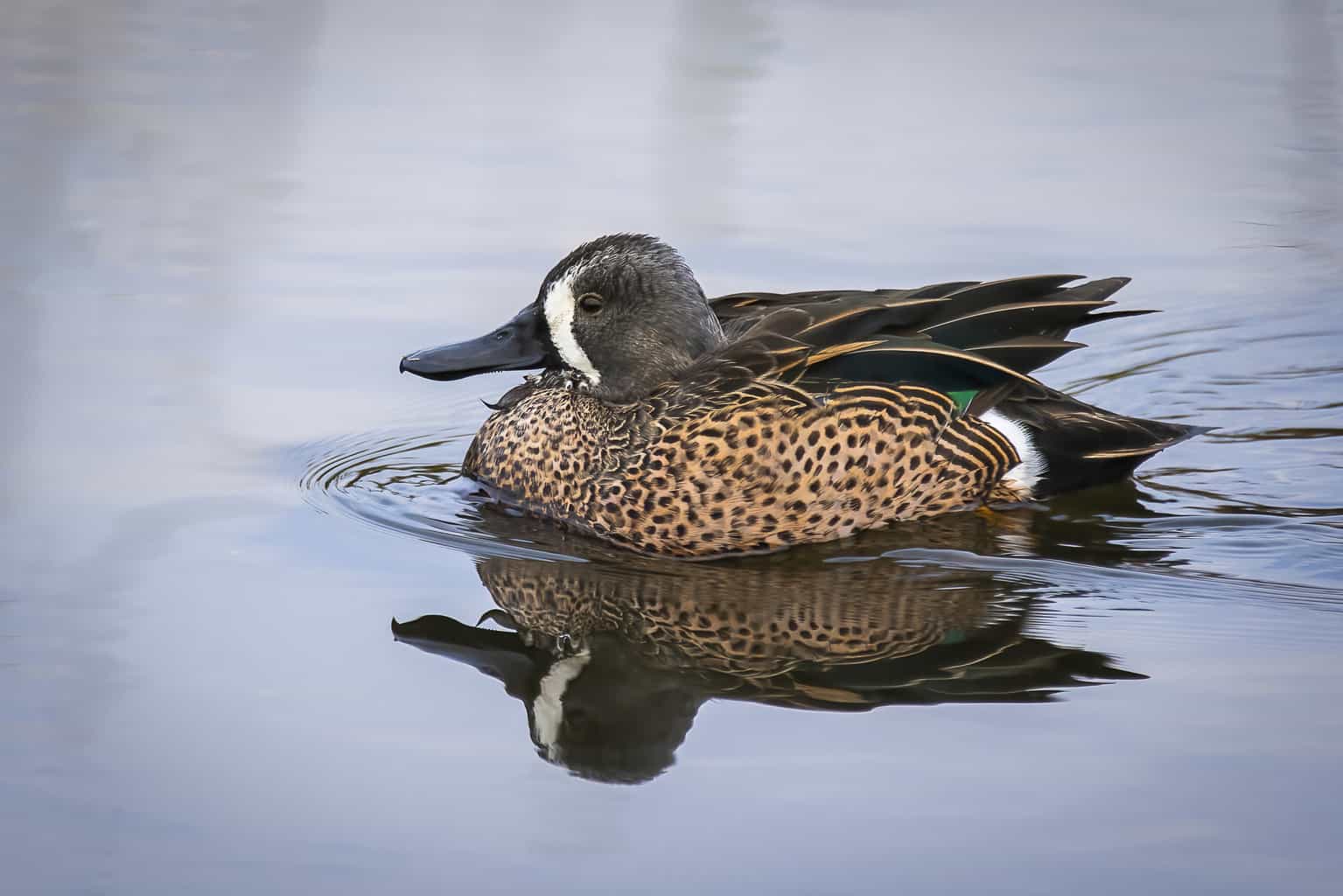
- Scientific Name: Spatula discors
- Length: 15 – 17 in
- Weight: Up to 19.18 oz
- Wingspan: 23 – 31 in
The third and final of the commonly seen duck species in Wisconsin over the summer months is the Blue-winged Teal.
These dabbling ducks are seen by around 7.5% of bird watchers on summer checklists, but disappear almost altogether in the winter when they prefer to spend their time in the Southern United States, and all the way down to the Caribbean and South America.
The best place to see Blue-winged Teals is in shallow, marshy ponds and mudflats, where they feed by stretching out their bill into muddy water, picking up seeds and plant material from near the surface.
Hooded Merganser

- Scientific Name: Lophodytes cucullatus
- Length: 15.8 – 19.3 inches
- Weight: 16 – 31 ounces
- Wingspan: 23.6 – 25 inches
Hooded Mergansers are the smallest but perhaps the most striking of the three common species of Merganser in the US. In the breeding season, the male’s raised white crest against the jet-black upper body is an impressive sight.
In the non-breeding season, the crests of both sexes lie flat, elongating the head, which some birders refer to as a ‘Hammerhead crest’.
The Hooded Merganser resides all year in Wisconsin, with it appearing between 2-3% on summer and winter checklists.
Like Wood Ducks, they nest in tree cavities and nest boxes but prefer to spend the rest of their time in shallow waters such as wooded ponds and swamps.
Northern Shoveler

- Scientific Name: Spatula clypeata
- Length: 19 inches
- Weight: 1.3 pounds
- Wingspan: 30 inches
The most distinctive characteristic of the Northern Shoveler is their huge, shovel-like beak which they use to strain the water’s surface for plankton and seeds.
Like Mallards, male Northern Shovelers have a gorgeous iridescent green head, but their chest and underside are very different, being white in color. Both adult males and females are also quite a bit slimmer than Mallards, often only weighing half that of their cousins.
Wisconsin lies between the main breeding grounds of the Northern Shoveler in Canada, and their favorite winter grounds in the Southern States.
A few of them, however, like to breed around the great lakes, and small flocks may even stick around for winter in mild years.
Red-breasted Merganser

- Scientific Name: Mergus serrator
- Length: 20 – 24 inches
- Weight: 29 – 35 oz
- Wingspan: 28 – 34 inches
Red-breasted Mergansers are not so often seen inland in the United States, preferring instead the coastal waters of the Atlantic and Pacific Oceans in the winter and the more northerly breeding grounds of Canada and Alaska in the summer.
The great lakes bordering the North and East of Wisconsin, however, seem large enough to attract these diving birds during winter, and a few can even be found nesting here at the southern point of their breeding range.
Red-breasted Mergansers are fierce fish hunters and sometimes even work in small teams to catch fish with their long, serrated bills.
Redhead
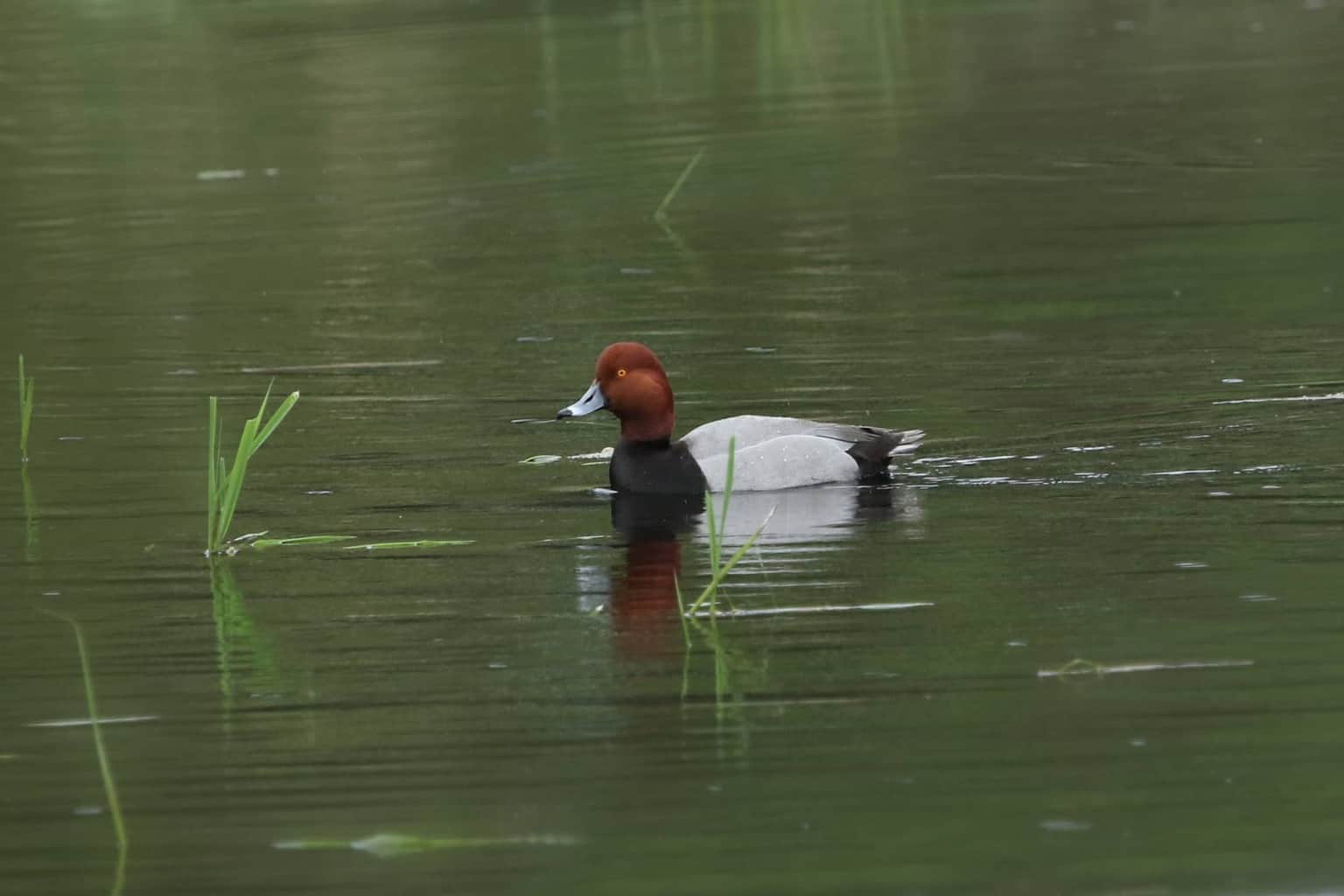
- Scientific Name: Aythya americana
- Length: 18 – 22 inches
- Weight: 32 – 40 oz
- Wingspan: 33 inches
The name Redhead is only fitting for the male of this large, diving duck – the female has a brown body, feathers, and head almost all over, although white-headed variants can also occasionally be seen.
Redheads’ main breeding grounds are usually in more western states of the US and Canada, although a few stop by to breed in Wisconsin. They like to nest in ponds with open water and tall, reedy, and abundant vegetation.
In the winter, though, Redheads enjoy swimming in open expanses of water, both in coastal waters and in the southern United States. The Great Lakes region is one of the few places you can find this duck in the northern inland states during the winter.
Ruddy Duck
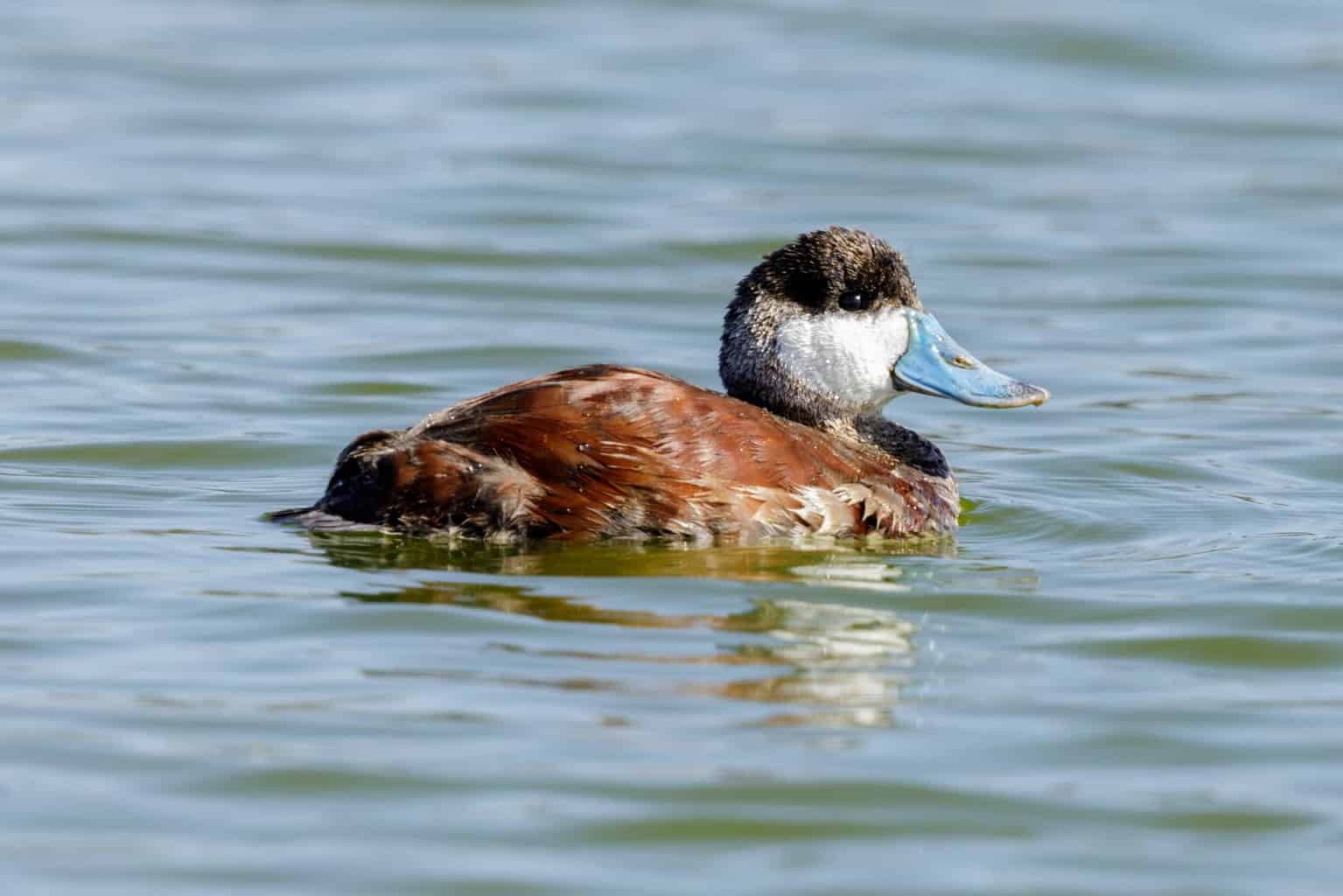
- Scientific Name: Oxyura jamaicensis
- Length: 13.5 – 17 inches
- Weight: 14.5 – 20.2 oz
- Wingspan: 18.5 inches
Ruddy Ducks are fairly small and compact ducks, and the main distinguishing feature is the bright white cheek of the male throughout the year. Interestingly, during the breeding season, his beak will also turn from gray to pale blue.
This species of duck is more common in the western parts of North America than the east, but small populations of Ruddy Ducks can be found throughout the mainland United States.
In Wisconsin they’re relatively uncommon during the summer, only being seen by less than 2% of bird watchers, and even rarer in the winter months.
Ruddy Ducks prefer open water for most of the year, but during the breeding season can be found nesting among marshy vegetation in shallow ponds.
Gadwall
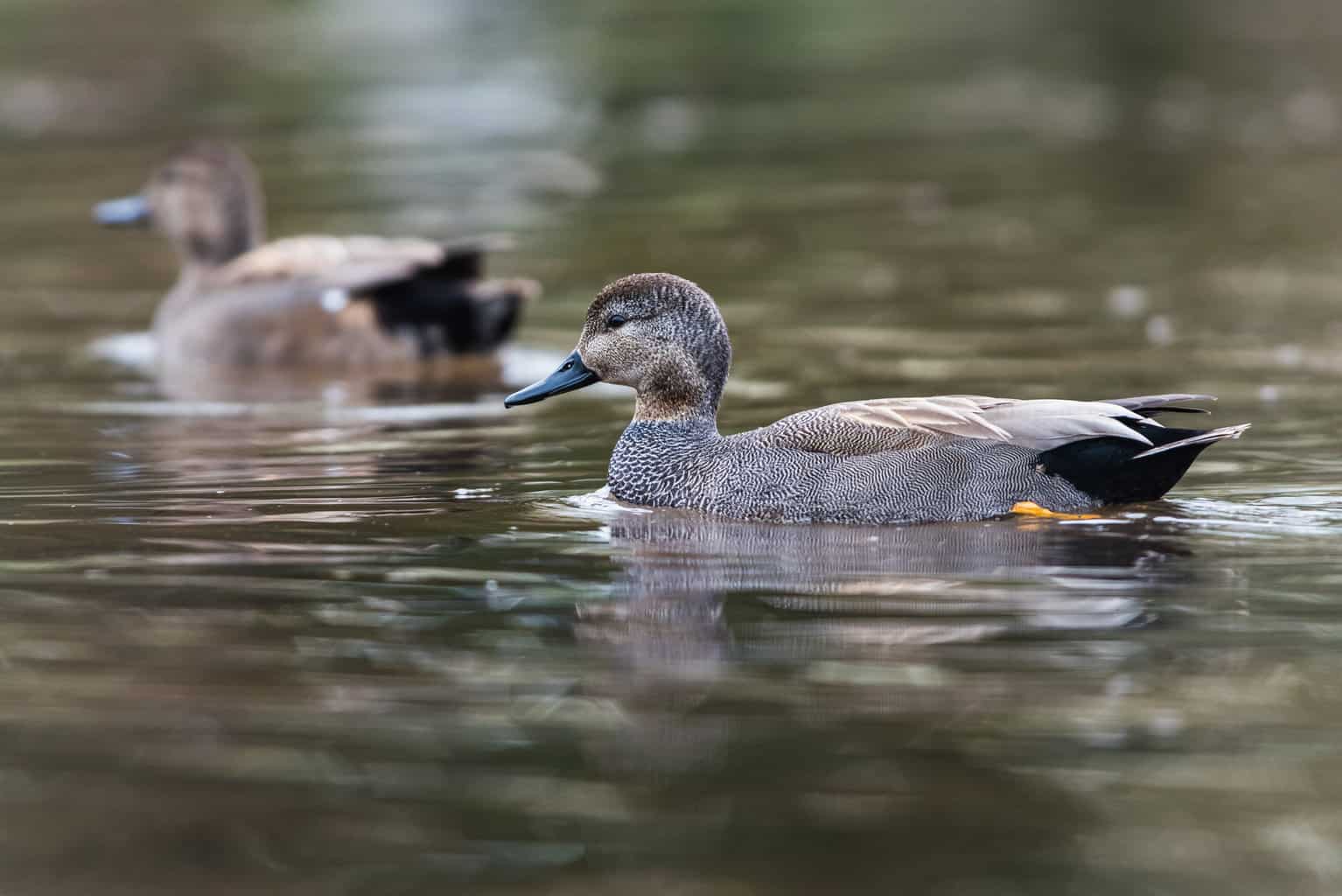
- Scientific Name: Mareca strepera
- Length: 18.1 – 22.4 inches
- Weight: 17.6 – 44.1 ounces
- Wingspan: 33.1 inches
Gadwalls are fairly large dabbling ducks, with rounded heads and quite modest plumage compared to most other ducks in Wisconsin. Even in the breeding season, males merely shift to a slightly different shade of brown-gray plumage.
Their only brighter colors are the red feathers confined to the upper side of their wings, which can be seen only from above when they’re in flight.
Gadwalls are equally infrequent in Wisconsin during the summer months as in the winter, but small numbers of them do breed in the state, nesting on the ground near water.
They can often be seen swimming or flying in small numbers alongside American Wigeons.
Ring Necked Duck

- Scientific Name: Aythya collaris
- Length: 15.3 – 18.1 inches
- Weight: 17.3 – 32.1 ounces
- Wingspan: 24.4 – 24.8 inches
Ring Necked Ducks are rather indistinctive during the winter season, but when breeding, the male has a highly contrasting black and white plumage, with a lovely white bar across his side that’s visible both in the water and in flight.
In Wisconsin, small numbers of them nest during the spring on ponds with plenty of dense vegetation. In winter they prefer fairly enclosed ponds and rivers, often nearby trees.
Ring Necked Ducks can be told apart from their much rarer cousins the Tufted Duck by their lack of the long tuft on the back of the head, which is present in all seasons in male Tufted Ducks.
Lesser Scaup

- Scientific Name: Aythya affinis
- Length: 15.3 – 18.1 inches
- Weight: 16 – 38.4 ounces
- Wingspan: 26.8 – 30.7 inches
Lesser Scaups are medium-sized diving ducks that are present all year round in Wisconsin. Although they’re easily confused with their cousins the Greater Scaup, there are a few ways to tell them apart.
Also known as ‘little bluebill’ Lesser Scaups are, unsurprisingly, a little smaller than Greater Scaups, and also have more of a pointed head compared with their relatives.
Whereas Lesser Scaups are seen equally often during the breeding season as in the winter, Greater Scaups rarely breed so far south. If you see one of these birds during the late spring-summer, it is almost certainly a Lesser Scaup.
The abundant remote lakes, ponds, and bodies of water in Wisconsin are ideal habitats for Lesser Scaups, who, unlike Greater Scaups, favor freshwater over saltwater. They enjoy eating shellfish, grains, and other parts of aquatic plants such as sedges and bulrushes.
Bufflehead

- Scientific Name: Bucephala albeola
- Length: 13 – 16 inches
- Weight: 11.5 – 16 ounces
- Wingspan: 22 inches
Weighing less than 1lb each, Buffleheads are the featherweights of ducks in the United States, and one of the smallest diving ducks in the country.
The breeding male is a striking bird, with a very large white cap on an otherwise dark red and green iridescent head.
Although they will occasionally nest near small ponds and rivers here, Buffleheads can be found much more frequently in Wisconsin out of the breeding season when the large, open lakes make an ideal winter habitat for them.
Mostly diving for their food, Buffleheads enjoy hunting various crustaceans, fish, insects, and mollusks.
Green-winged Teal
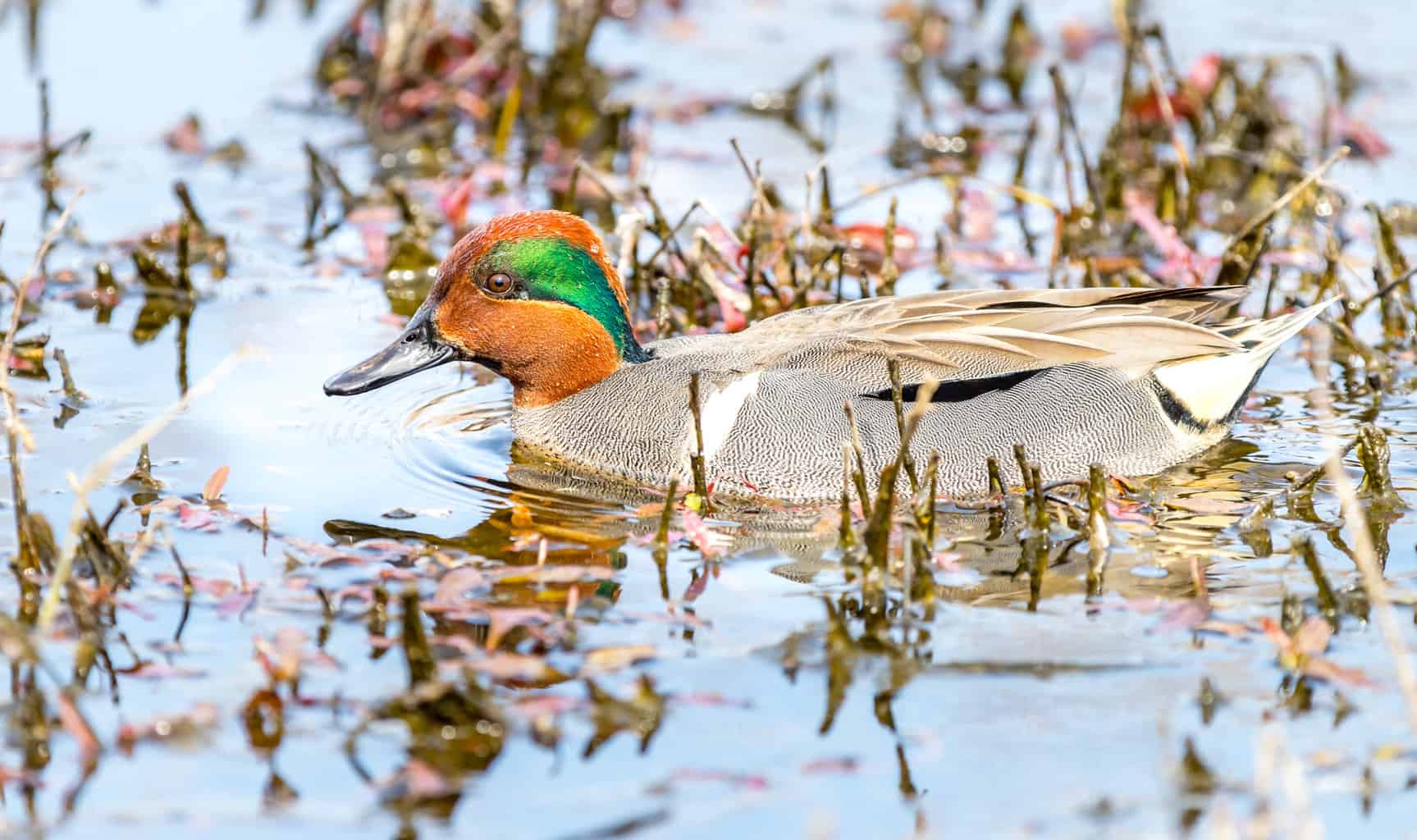
- Scientific Name: Anas carolinensis
- Length: 12.2 – 15.3 inches
- Weight: 4.9 – 17.6 ounces
- Wingspan: 20.5 – 23.2 inches
The Green-winged Teal is a tiny but beautiful dabbling duck that closely resembles the Eurasian Teal, now known to be a different species.
With a huge migratory range from the Arctic Circle to Central America, you may well see these ducks passing through Wisconsin in huge flocks during their spring and autumn passages.
A small number of them will also stop in order to breed here, but they are very seldom seen in the state over winter.
More than any other duck species, Green-winged Teals prefer to feed on mudflats, marshes, and flooded fields rather than open water. Their diet is mainly vegetarian, consisting of seeds, stems, and leaves of emergent and aquatic vegetation as their main staple.
American Wigeon

- Scientific Name: Mareca americana
- Length: Up to 14 inches
- Weight: 29 – 36 oz
- Wingspan: 30 – 34 inches
American Wigeons are fairly rare sightings in Wisconsin during the breeding season and are absent altogether during the winter.
Large flocks of them may, however, be seen during the migration season as they pass from the Southern United States to their breeding grounds in the northwest and Canada, and back again.
These small, plump ducks may be seen grazing fields in large numbers during their transit through, especially in the fall when they can take advantage of grains left over from harvests!
Northern Pintails

- Scientific Name: Anas acuta
- Length: 20 – 30 inches
- Weight: 1 – 3 pounds
- Wingspan: 20 – 30 inches
Like American Wigeons, Northern Pintails are more of a transitory species than a resident in Wisconsin.
While very small numbers of them do breed and overwinter in the state, most Northern Pintails breed further north and overwinter further south, leaving Wisconsin just as a state they pass through in large flocks, during spring and fall.
Amazingly, Northern Pintails can cross-breed with Mallards, forming an extremely beautiful hybrid that has the gorgeous green head of a Mallard, with the slender body and long tail feathers of a Pintail!
Ducks That You’re More Likely To See During The Winter
The following species of ducks are rarely seen in Wisconsin during the summer months but are more common over the winter. Many of them come to take advantage of the deep water lakes in and around Wisconsin which, despite cold temperatures, rarely freeze over completely.
Common Merganser

- Scientific Name: Mergus merganser
- Length: 22 – 27 in
- Weight: 59 – 60.8 oz
- Wingspan: 31 – 37 in
Common Mergansers are pretty rare during the summer in Wisconsin, only being seen by about 1% of birdwatchers, but during the winter they are the third most frequently-spotted duck, after Mallards and Common Goldeneyes.
These are the largest of the three Mergansers found in North America and their European name ‘Goosander’ gives us a clue about just how big they get!
As big, powerful divers, Common Mergansers prefer to live on deep, clear lakes and rivers and rely on fish as their main source of food. It’s no surprise then, that the many large, deep lakes of Wisconsin make a perfect winter habitat for them.
Common Goldeneye

- Scientific Name: Bucephala Clangula
- Length: 16 – 20 inches
- Weight: 21 – 29.1 oz
- Wingspan: 30.3 – 32.7 inches
This is one of those bird species whose name gives us a great head start in identifying them. Both male and female Goldeneyes do indeed have strikingly yellow eyes, set against dark brown to green-black heads.
Because their breeding grounds are much further north, Common Goldeneyes are seldom seen in Wisconsin during the summer, but in winter numerous flocks of them gather upon open lakes – their favorite winter habitat.
These medium-sized diving ducks feed mainly on crustaceans, fish, insects, and mollusks.
American Black Duck
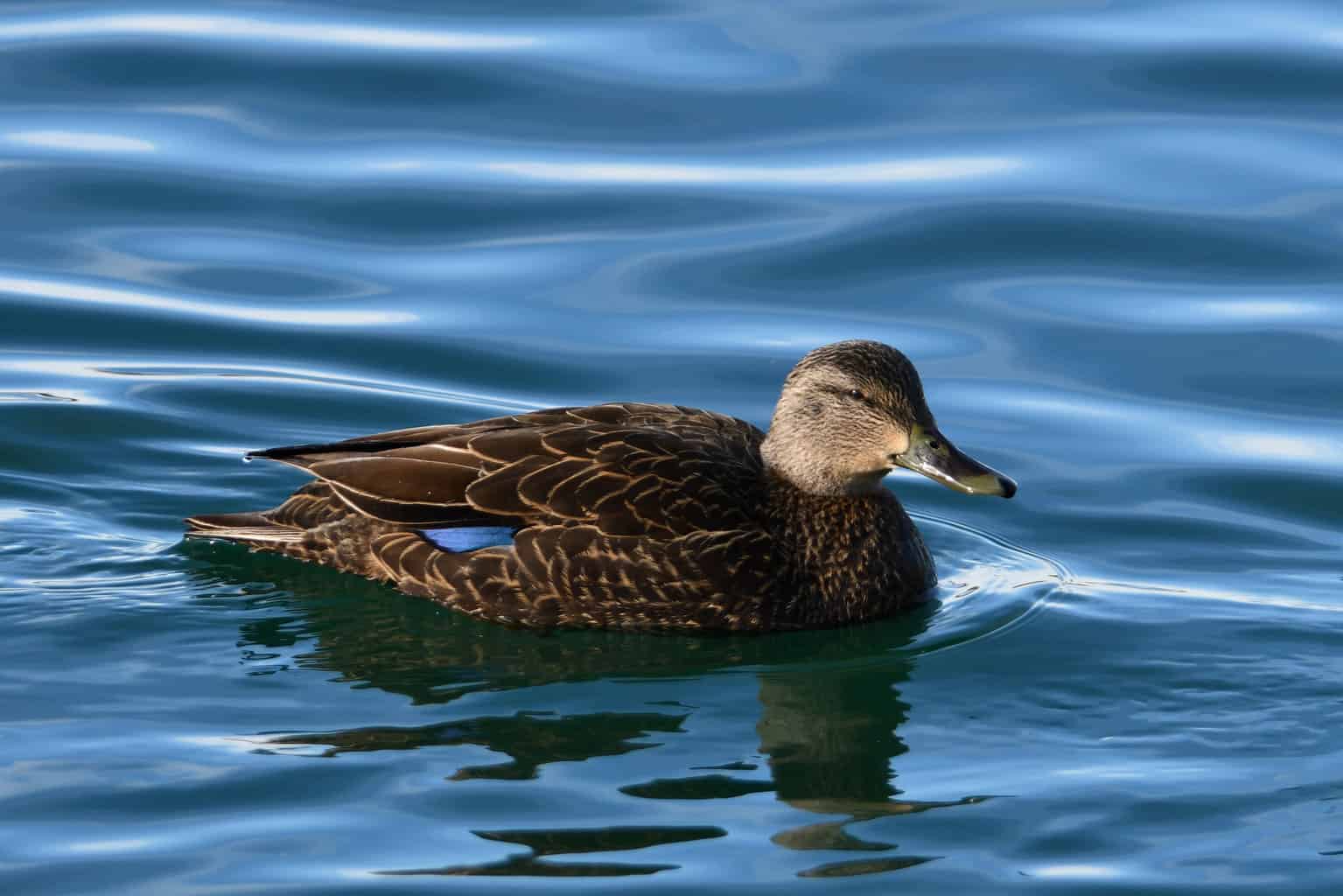
- Scientific Name: Anas rubripes
- Length: 19 – 23 in
- Weight: Up to 49.6 oz
- Wingspan: 33 – 36 in
American Black Ducks are so closely related to Mallards that the two species can hybridize and produce offspring that look like something between the two species.
It can be very difficult to tell them apart from Mallards by eye, although, as the name suggests, American Black Ducks are rather darker in color.
This large dabbling duck is more commonly found along the Atlantic Coast than inland but seems to enjoy the Great Lakes area for overwintering too.
Canvasback
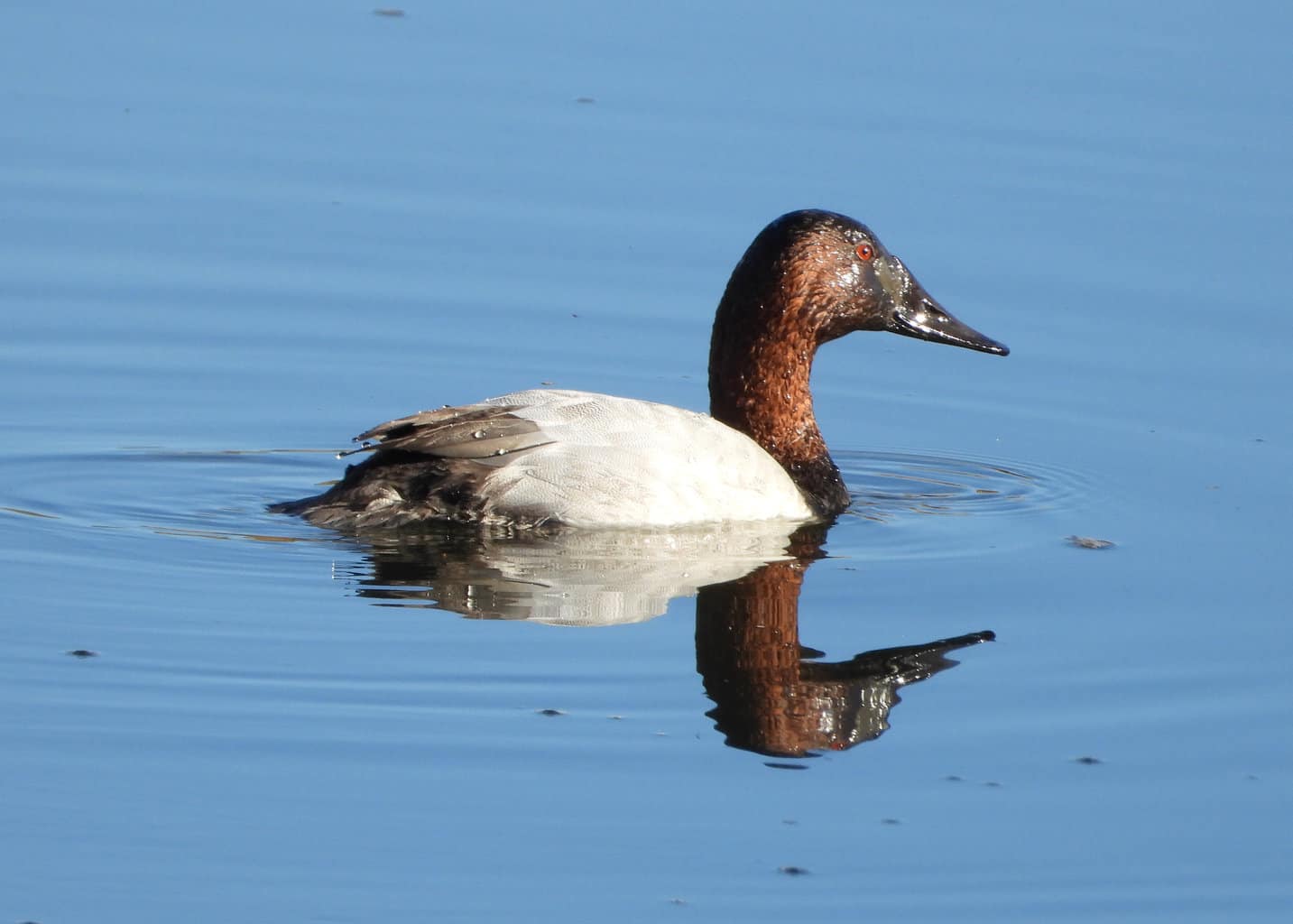
- Scientific Name: Aythya valisineria
- Length: 19 – 24 in
- Weight: Up to 58.48 oz
- Wingspan: 28 – 36 in
A fast-flying duck with a wingspan of up to 3 feet, Canvasbacks are large diving ducks with canvas-white or gray backs. Males also have a lovely cinnamon-red head and throat, with red eyes, while female ducks have a brown head with dark eyes.
Canvasbacks spend their breeding season in the northwest of the continent, right up into Alaska, and typically overwinter on the west coast or in the southern states.
It’s interesting then, that a few isolated populations decide to spend their winter upon the Great Lakes – perhaps the large expanses of deep water are just too much for them to resist!
Long-tailed Duck

- Scientific Name: Clangula hyemalis
- Length: 15 – 22 in
- Weight: 31.74 oz
- Wingspan: 26 – 31 in
Long-tailed Ducks are a special sighting in Wisconsin. These birds are usually considered sea ducks and can hardly be found inland anywhere else in the country except the Great Lakes.
With its characteristic long tail that’s apparent both in flight and while swimming, this stocky duck is distinctive in appearance and a prized sighting in Wisconsin.
Breeding from the Hudson Bay, right the way across to Alaska, this bird can only be seen in extremely northern latitudes during the breeding season, but, in winter, a few of them seem to enjoy Wisconsin and the surrounding states for the huge lakes. Maybe it reminds them of the sea!
Greater Scaup

- Scientific Name: Aythya marila
- Length: 15.3 – 22.1 in
- Weight: 25.6 – 48.0 oz
- Wingspan: 28.4 – 31.1 in
Also known as ‘Bluebill’, Greater Scaups are medium-sized ducks and slightly larger than their cousins the Lesser Scaup.
As a species, Greater Scaups have an enormous range, breeding around the globe in northern latitudes from Canada to Siberia. In the colder months, they tend to migrate to coastal waters but are common around the Great Lakes in winter too.
On their diving forays, Greater Scaups enjoy eating mollusks, plants, and aquatic insects. These intriguing ducks sometimes form large groups called ‘rafts’ that can comprise thousands of birds!
Conclusion
Owing to its thousands of lakes, large rivers, and national parks, Wisconsin is a great state to see ducks.
Whether it’s a glamorous Wood Duck nesting in a tree during the spring, a massive flock of American Wigeon in the fall, or a raft of Greater Scaups on the Great Lakes during winter, there are plenty of ducks to be seen all year round in the Badger state.
To find out about more fascinating birds in the area, be sure to check out our guide to 25 of the most iconic birds in Wisconsin here.

